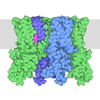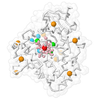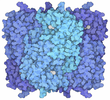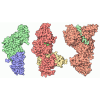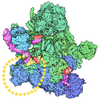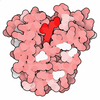[English] 日本語
 Yorodumi
Yorodumi- PDB-1niw: Crystal structure of endothelial nitric oxide synthase peptide bo... -
+ Open data
Open data
- Basic information
Basic information
| Entry | Database: PDB / ID: 1niw | ||||||
|---|---|---|---|---|---|---|---|
| Title | Crystal structure of endothelial nitric oxide synthase peptide bound to calmodulin | ||||||
 Components Components |
| ||||||
 Keywords Keywords | SIGNALING PROTEIN/OXIDOREDUCTASE / Nitric oxide / calcium-binding protein / NOS / SIGNALING PROTEIN-OXIDOREDUCTASE COMPLEX | ||||||
| Function / homology |  Function and homology information Function and homology informationregulation of store-operated calcium channel activity / : / : / regulation of the force of heart contraction by chemical signal / NOSIP mediated eNOS trafficking / negative regulation of muscle hyperplasia / tetrahydrobiopterin metabolic process / NOSTRIN mediated eNOS trafficking / regulation of response to tumor cell / positive regulation of autophagic cell death ...regulation of store-operated calcium channel activity / : / : / regulation of the force of heart contraction by chemical signal / NOSIP mediated eNOS trafficking / negative regulation of muscle hyperplasia / tetrahydrobiopterin metabolic process / NOSTRIN mediated eNOS trafficking / regulation of response to tumor cell / positive regulation of autophagic cell death / DAPK1-calmodulin complex / smooth muscle hyperplasia / regulation of nervous system process / : / : / : / : / superoxide-generating NAD(P)H oxidase activity / : / ovulation from ovarian follicle / pulmonary valve morphogenesis / response to fluid shear stress / negative regulation of biomineral tissue development / Nitric oxide stimulates guanylate cyclase / establishment of protein localization to mitochondrial membrane / regulation of systemic arterial blood pressure by endothelin / type 3 metabotropic glutamate receptor binding / ROS and RNS production in phagocytes / establishment of protein localization to membrane / tetrahydrobiopterin binding / aortic valve morphogenesis / arginine binding / endocardial cushion morphogenesis / positive regulation of DNA binding / negative regulation of high voltage-gated calcium channel activity / negative regulation of ryanodine-sensitive calcium-release channel activity / organelle localization by membrane tethering / mitochondrion-endoplasmic reticulum membrane tethering / ventricular septum morphogenesis / autophagosome membrane docking / negative regulation of calcium ion export across plasma membrane / positive regulation of Notch signaling pathway / regulation of cardiac muscle cell action potential / presynaptic endocytosis / nitric-oxide synthase binding / regulation of synaptic vesicle exocytosis / calcineurin-mediated signaling / cadmium ion binding / negative regulation of calcium ion transport / negative regulation of potassium ion transport / adenylate cyclase binding / regulation of ryanodine-sensitive calcium-release channel activity / protein phosphatase activator activity / negative regulation of platelet activation / actin monomer binding / nitric oxide mediated signal transduction / blood vessel remodeling / nitric-oxide synthase (NADPH) / positive regulation of blood vessel endothelial cell migration / detection of calcium ion / regulation of synaptic vesicle endocytosis / regulation of cardiac muscle contraction / catalytic complex / postsynaptic cytosol / nitric-oxide synthase activity / endothelial cell migration / L-arginine catabolic process / negative regulation of extrinsic apoptotic signaling pathway via death domain receptors / activation of adenylate cyclase activity / cellular response to interferon-beta / phosphatidylinositol 3-kinase binding / calcium channel inhibitor activity / presynaptic cytosol / positive regulation of nitric-oxide synthase activity / regulation of release of sequestered calcium ion into cytosol by sarcoplasmic reticulum / negative regulation of blood pressure / regulation of sodium ion transport / enzyme regulator activity / response to hormone / nitric oxide metabolic process / eNOS activation / titin binding / Tetrahydrobiopterin (BH4) synthesis, recycling, salvage and regulation / sperm midpiece / regulation of calcium-mediated signaling / voltage-gated potassium channel complex / nitric oxide biosynthetic process / potassium ion transmembrane transport / calcium channel complex / homeostasis of number of cells within a tissue / removal of superoxide radicals / regulation of heart rate / lung development / cell redox homeostasis / lipopolysaccharide-mediated signaling pathway / response to amphetamine / calyx of Held / adenylate cyclase activator activity / blood vessel diameter maintenance / sarcomere Similarity search - Function | ||||||
| Biological species |  | ||||||
| Method |  X-RAY DIFFRACTION / X-RAY DIFFRACTION /  SYNCHROTRON / SYNCHROTRON /  MAD / Resolution: 2.05 Å MAD / Resolution: 2.05 Å | ||||||
 Authors Authors | Aoyagi, M. / Arvai, A.S. / Tainer, J.A. / Getzoff, E.D. | ||||||
 Citation Citation |  Journal: Embo J. / Year: 2003 Journal: Embo J. / Year: 2003Title: Structural basis for endothelial nitric oxide synthase binding to calmodulin Authors: Aoyagi, M. / Arvai, A.S. / Tainer, J.A. / Getzoff, E.D. | ||||||
| History |
|
- Structure visualization
Structure visualization
| Structure viewer | Molecule:  Molmil Molmil Jmol/JSmol Jmol/JSmol |
|---|
- Downloads & links
Downloads & links
- Download
Download
| PDBx/mmCIF format |  1niw.cif.gz 1niw.cif.gz | 150.9 KB | Display |  PDBx/mmCIF format PDBx/mmCIF format |
|---|---|---|---|---|
| PDB format |  pdb1niw.ent.gz pdb1niw.ent.gz | 120.2 KB | Display |  PDB format PDB format |
| PDBx/mmJSON format |  1niw.json.gz 1niw.json.gz | Tree view |  PDBx/mmJSON format PDBx/mmJSON format | |
| Others |  Other downloads Other downloads |
-Validation report
| Summary document |  1niw_validation.pdf.gz 1niw_validation.pdf.gz | 505.5 KB | Display |  wwPDB validaton report wwPDB validaton report |
|---|---|---|---|---|
| Full document |  1niw_full_validation.pdf.gz 1niw_full_validation.pdf.gz | 527 KB | Display | |
| Data in XML |  1niw_validation.xml.gz 1niw_validation.xml.gz | 34.9 KB | Display | |
| Data in CIF |  1niw_validation.cif.gz 1niw_validation.cif.gz | 45.7 KB | Display | |
| Arichive directory |  https://data.pdbj.org/pub/pdb/validation_reports/ni/1niw https://data.pdbj.org/pub/pdb/validation_reports/ni/1niw ftp://data.pdbj.org/pub/pdb/validation_reports/ni/1niw ftp://data.pdbj.org/pub/pdb/validation_reports/ni/1niw | HTTPS FTP |
-Related structure data
| Similar structure data |
|---|
- Links
Links
- Assembly
Assembly
| Deposited unit | 
| ||||||||
|---|---|---|---|---|---|---|---|---|---|
| 1 | 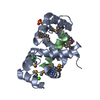
| ||||||||
| 2 | 
| ||||||||
| 3 | 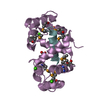
| ||||||||
| 4 | 
| ||||||||
| 5 | 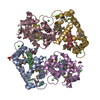
| ||||||||
| 6 | 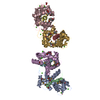
| ||||||||
| 7 | 
| ||||||||
| 8 | 
| ||||||||
| Unit cell |
|
- Components
Components
-Protein / Protein/peptide , 2 types, 8 molecules ACEGBDFH
| #1: Protein | Mass: 17143.406 Da / Num. of mol.: 4 Source method: isolated from a genetically manipulated source Source: (gene. exp.)   #2: Protein/peptide | Mass: 2183.636 Da / Num. of mol.: 4 / Fragment: Calmodulin binding region / Source method: obtained synthetically Details: The peptide was chemically synthesized. The sequence of the peptide occurs naturally in Homo sapiens (human). References: UniProt: P29474, nitric-oxide synthase (NADPH) |
|---|
-Non-polymers , 4 types, 284 molecules 
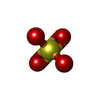
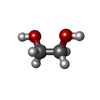
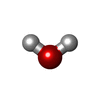



| #3: Chemical | ChemComp-CA / #4: Chemical | ChemComp-SO4 / | #5: Chemical | ChemComp-EDO / #6: Water | ChemComp-HOH / | |
|---|
-Details
| Has protein modification | Y |
|---|
-Experimental details
-Experiment
| Experiment | Method:  X-RAY DIFFRACTION / Number of used crystals: 1 X-RAY DIFFRACTION / Number of used crystals: 1 |
|---|
- Sample preparation
Sample preparation
| Crystal | Density Matthews: 2.19 Å3/Da / Density % sol: 43.5 % | ||||||||||||||||||||||||||||||||||||||||||||||||||||||||
|---|---|---|---|---|---|---|---|---|---|---|---|---|---|---|---|---|---|---|---|---|---|---|---|---|---|---|---|---|---|---|---|---|---|---|---|---|---|---|---|---|---|---|---|---|---|---|---|---|---|---|---|---|---|---|---|---|---|
| Crystal grow | Temperature: 298 K / Method: vapor diffusion / pH: 5 Details: Polyethylene glycol, ammonium sulfate, pH 5, VAPOR DIFFUSION, temperature 298K | ||||||||||||||||||||||||||||||||||||||||||||||||||||||||
| Crystal grow | *PLUS pH: 7.5 / Method: vapor diffusion, hanging drop | ||||||||||||||||||||||||||||||||||||||||||||||||||||||||
| Components of the solutions | *PLUS
|
-Data collection
| Diffraction | Mean temperature: 100 K | ||||||||||||
|---|---|---|---|---|---|---|---|---|---|---|---|---|---|
| Diffraction source | Source:  SYNCHROTRON / Site: SYNCHROTRON / Site:  SSRL SSRL  / Beamline: BL9-2 / Wavelength: 0.979214, 0.979071, 0.911656 / Beamline: BL9-2 / Wavelength: 0.979214, 0.979071, 0.911656 | ||||||||||||
| Detector | Type: ADSC QUANTUM 4 / Detector: CCD / Date: Mar 20, 2001 | ||||||||||||
| Radiation | Protocol: MAD / Monochromatic (M) / Laue (L): M / Scattering type: x-ray | ||||||||||||
| Radiation wavelength |
| ||||||||||||
| Reflection | Resolution: 2.05→30 Å / Num. obs: 41637 / % possible obs: 99.9 % / Observed criterion σ(I): 4 / Redundancy: 9.2 % / Biso Wilson estimate: 24.1 Å2 / Rsym value: 0.09 / Net I/σ(I): 26.6 | ||||||||||||
| Reflection shell | Resolution: 2.05→2.12 Å / Mean I/σ(I) obs: 3.3 / Num. unique all: 4140 / Rsym value: 0.402 / % possible all: 99.9 | ||||||||||||
| Reflection | *PLUS Lowest resolution: 20 Å / Num. obs: 41626 / % possible obs: 99.7 % / Num. measured all: 129886 / Rmerge(I) obs: 0.06 | ||||||||||||
| Reflection shell | *PLUS % possible obs: 99 % / Rmerge(I) obs: 0.35 / Mean I/σ(I) obs: 3.76 |
- Processing
Processing
| Software |
| ||||||||||||||||||||||||||||||||||||
|---|---|---|---|---|---|---|---|---|---|---|---|---|---|---|---|---|---|---|---|---|---|---|---|---|---|---|---|---|---|---|---|---|---|---|---|---|---|
| Refinement | Method to determine structure:  MAD / Resolution: 2.05→19.78 Å / Rfactor Rfree error: 0.005 / Isotropic thermal model: RESTRAINED / Cross valid method: THROUGHOUT / σ(F): 0 / Stereochemistry target values: Engh & Huber MAD / Resolution: 2.05→19.78 Å / Rfactor Rfree error: 0.005 / Isotropic thermal model: RESTRAINED / Cross valid method: THROUGHOUT / σ(F): 0 / Stereochemistry target values: Engh & Huber
| ||||||||||||||||||||||||||||||||||||
| Solvent computation | Solvent model: FLAT MODEL / Bsol: 42.0718 Å2 / ksol: 0.317885 e/Å3 | ||||||||||||||||||||||||||||||||||||
| Displacement parameters | Biso mean: 44.5 Å2
| ||||||||||||||||||||||||||||||||||||
| Refine analyze |
| ||||||||||||||||||||||||||||||||||||
| Refinement step | Cycle: LAST / Resolution: 2.05→19.78 Å
| ||||||||||||||||||||||||||||||||||||
| Refine LS restraints |
| ||||||||||||||||||||||||||||||||||||
| LS refinement shell | Resolution: 2.05→2.18 Å / Rfactor Rfree error: 0.018 / Total num. of bins used: 6
| ||||||||||||||||||||||||||||||||||||
| Refinement | *PLUS % reflection Rfree: 5 % / Rfactor Rfree: 0.248 / Rfactor Rwork: 0.222 | ||||||||||||||||||||||||||||||||||||
| Solvent computation | *PLUS | ||||||||||||||||||||||||||||||||||||
| Displacement parameters | *PLUS | ||||||||||||||||||||||||||||||||||||
| Refine LS restraints | *PLUS
|
 Movie
Movie Controller
Controller


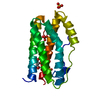

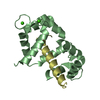

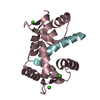
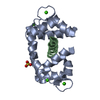
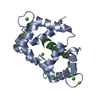



 PDBj
PDBj

